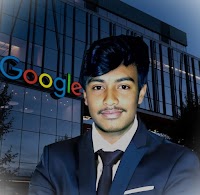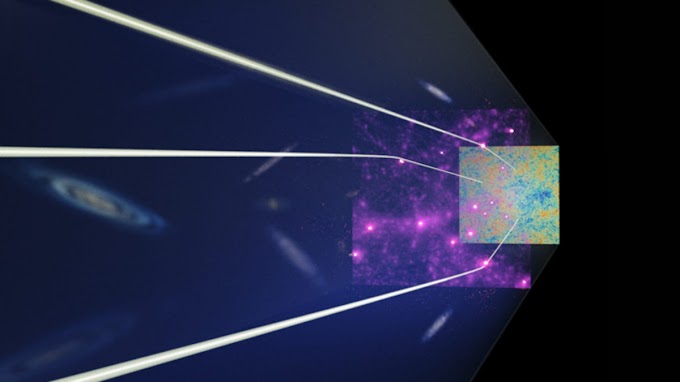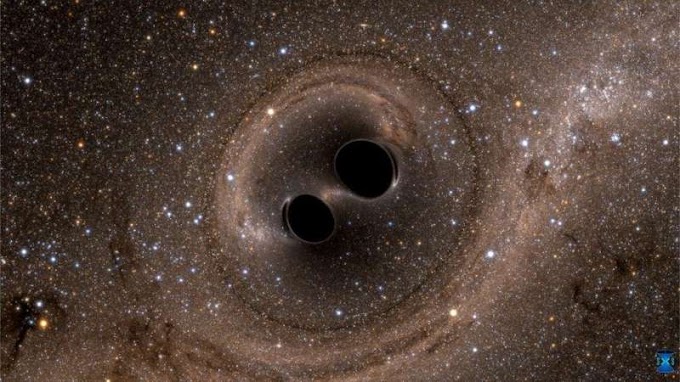We know that , A Black-Hole is usually where information goes to disappear . But Scientists may have found a new trick to use its last moments to tell us about more unknown history of the Universe .
Two Astrophysicists of University of Chicago has published a new study in Physical Review Letters . There they laid out a method for how to use pairs of colliding Black-Holes to measure –
- How Fast our Universe is Expanding ?
- And thus understand how our Universe evolved ?
- What it is made out of ?
- And where it's going ?
Scientists are thinking about the new technique , which they call a “ Spectral Siren ” , may be able to tell us more about the otherwise elusive “ Teenage ” years of the Universe .
Also Read :: Top 5 Major Space Mission of 2022
One of the major ongoing scientific debate is— Exactly How Fast Our Universe is Expanding ? A major number called the Hubble Constant . But there are also some different methods available so far yield slightly different answers , and Scientists are eager to find alternative ways to measure this rate . The accuracy of this number is especially important because it affects our understanding of fundamental questions, like —
- The Age
- History
- MakeUp
- Evolution
of the Universe .
The New Trick offers a way to make this calculation , using special detectors that pick-up the cosmic echoes of Black-Hole collisions .
Two Black-Holes slams into each-other , is so powerful event , which creates a ripple in Space-Time , that travels across the Universe . Here the U.S. Laser Interferometer Gravitational-Wave Observatory ( LIGO ) and the Italian Laser Interferometer Gravitational-Wave Observatory ( VIRGO ) can pick-up those Ripples from the Earth Surface , which are called Gravitational Waves . Over the past few years , LIGO and VIRGO have collected the signal from almost 100 pairs of Black-Holes colliding .
The signal from every collision contains information about – How Massive the Black-Holes were . But don't signal travels across the space , and during that specific time the universe has expanded more , which change the properties of the signal . “ For example , if you took a black hole and put it earlier in the universe , the signal would change and it would look like a bigger black hole then it really is ” , Explained by Astrophysicist Daniel Holz , University of Chicago , One of the two Scientists of the Study .
If Scientists can able to figure out a way to measure – How the Signal Changed , they can easily calculate the accurate Rate of Expansion of the Universe . Here the problem is : How do they know , how much the Signal has changed from the original ?
In their new research paper Holz and Jose Maria Ezquiaga , Astrophysicist of University of Chicago , one of the two Scientists of the Study suggested that – They can use the newfound knowledge about the whole population of Black-Holes as a Calibration-Tool . “ For example , current evidence suggests that most of the detected Black-Holes have between 5 and 40 times the mass of our Sun . So , we measure the masses of the nearby Black-Holes and understand their features , and then we look further away and see how much those further ones appear to have shifted . And this gives us a measure of the expansion of the universe ” said Ezquiaga .
This two Scientists dub it the “ Spectral Siren ” method , a new approach to the “ Standard Siren ” method , which Holz and Ezquiaga have been pioneering . The name is a reference to the “ Standard Candle ” method , also used in Astronomy .
 |
| An artist's impression of two black holes about to collide and merge . Credit : MARK GARLICK / SCIENCE PHOTO / GETTY IMAGES |
The Scientists are excited because in future , as LIGO's capabilities expand , this method may provide a unique window , into the “ Teenage ” years of the Universe , about 12 Billion Light-Year ago , which are hard to study with other methods .
Scientists can use Cosmic-Microwave Background to look at the very earliest moments of the Universe . And they can look around at Galaxies near our own Galaxy to study the Universe's most recent history . But the in-between period is harder to reach , and it's an area of special scientific interest .
“ It's around the time that will switch from Dark-Matter being the predominant force in the universe to dark energy taking over , and we are very interested in studying this critical transition . ” Ezquiaga stated .
Also Read :: NASA's Artemis-1 : Here's Everything , You Have To Know About The Mission
The other advantage of this method , the Scientists said , is that there are fewer uncertainties created by gaps in our Scientific Knowledge . “ By using the entire population of Black-Holes the method can calibrate itself , directly identifying and correcting for errors . ” Holz stated . The other methods used to calculate the Hubble Constant , rely on our current understanding of the Physics of Stars and Galaxies . This involves a lot of complications of Astrophysics . That means , the measurements might be thrown-off quite a bit , if there is something , we don't know yet .
 |
| Artist's impression of binary black holes about to collide. Credit : Mark Myers, OzGrav-Swinburne University. |
This new Black-Hole method relies almost purely on Einstein's Theory of Gravity , which is well studied and has stood-up against all the ways , Scientists have tried to test it so far .
The more data they have from all Black-Holes , the more accurate this calibration will be . “ We need preferably thousands of these signals , which we should have in a few years , and even more in the next decade or two . At that point it would be incredibly powerful method to learn about the Universe .” Holz stated .
When black holes collide, they could cause nearby material to radiate with light. A 2020 study made the first-ever observation of a flare that may have been produced when two smaller black holes merged to form a new, larger black hole: https://t.co/ign9NtsXc2#BlackHoleFriday pic.twitter.com/lRmUEe4bBB
— NASA (@NASA) November 26, 2021
This new method can help us to know more about — Exactly How Fast Our Universe is Expanding ?












